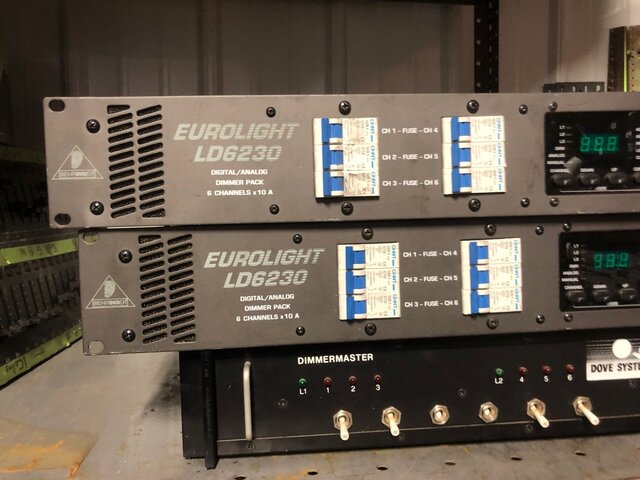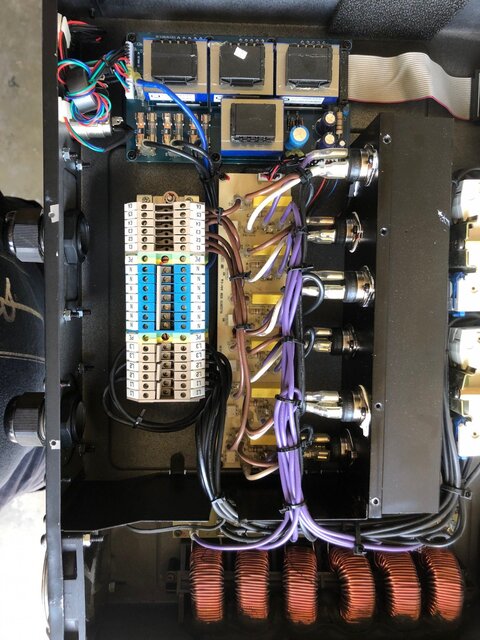You are using an out of date browser. It may not display this or other websites correctly.
You should upgrade or use an alternative browser.
You should upgrade or use an alternative browser.
Has anyone wired one of these dimmers? Behringer EuroLight LD6230
- Thread starterlilricky
- Start date
@lilricky Did you receive any paperwork with your dimmers; color code, wiring info' or an instruction manual?
At a glance, a few observations: Internally it appears to be set up for 120 / 240 volt, single phase operation with four 10 amp dimmers per leg. There's also the possibility of rewiring it for 120 / 208 volt three phase operation.
Was it shipped with a power cable included??
If so, what are the colours of insulation on the individual conductors within the power cord???
A VOM, or simple battery powered continuity tester, would allow you to identify the ground conductor.
Tell us more and I'm confident other will post soon, if they haven't already while I've been typing.
Toodleoo!
Ron Hebbard
I don't see that in this version of the User Manual.pdf. The way I read it, the pack requires 3Ø 120/208VAC, Wye-connected 20A/leg (HHHNG) for 60A total. The pack can be connected to 1Ø, 120V (HNG) for 20A total. As far as I can see at a cursory glance, there is no provision for split-phase 120/240VAC (HHNG) input.
Even if they have, ControlBooth's rules forbid "how to" electrical advice. Consult a qualified electrician, in person.So, hopefully someone has actually hooked up mains to one of these guys.
@cbrandt Definitely! Writing in support. (I was an IBEW installation and maintenance electrician prior to retiring)
Things you commonly count on a manual for include electrical requirements, acceptable voltages, currents at specific voltages, minimal physical clearances, air flow directions and volumes for minimal ventilation, acceptable ambient operating temperatures, acceptable moisture / condensation range.
A common end user error when racking audio amplifiers is failing to consider the direction of air flow. Too often users will mount an amplifier which draws cooling air in from the rear and exhausts out the front immediately below an amplifier that draws air in from the front and exhausts out the rear; this leads to the two amplifiers essentially cooking each other to death or at least an over-temp shutdown.
Think about it: Warm air exhausts out the front of the lower amplifier only to rise and be drawn in by the amplifier above then exhausted out the rear into a neatly enclosed rack and drawn right back into the amplifier below.
Dimmer racks, even permanently installed dimmer racks, require the same considerations.
One of my last installations prior to my mini-stroke was the installation of four Johnson Systems Icon series dimmer racks. Four racks, each containing 24 dimmers. Shaun definitely includes information regarding air temperature and flow considerations and prominently recommends a minimal amount of clearance when mounting racks one above the other on a wall; mounting racks beside each other can be accommodated in appreciably less square footage of wall space as all racks will draw air in from the bottom and exhaust out the top.
Toodleoo!
Ron Hebbard
Les
Well-Known Member
JD
Well-Known Member
The connections are pretty straight forth. You just have to tell the electrician if you are tying it into split phase (HHNG) or three phase (HHHNG) power. Note- by Split Phase I am referring to 120-0-120 being either 240 or 208 between hots depending on the service. Both would require a 4 blade/pin connector of the correct ampacity and would function correctly. Three phase would require a 5 blade/pin connector.
Similar threads
- Replies
- 7
- Views
- 515
- Replies
- 8
- Views
- 3K
- Replies
- 8
- Views
- 2K
Users who are viewing this thread
Total: 1 (members: 0, guests: 1)




